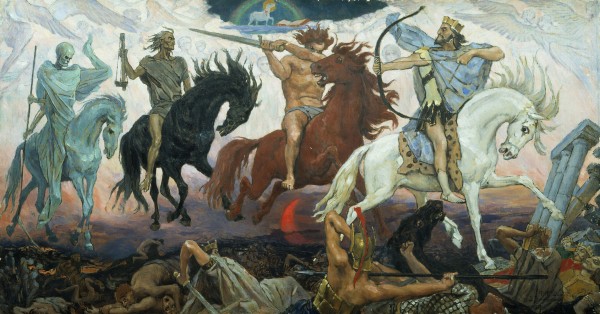Peter S. Williamson, Revelation. Catholic Commentary on Sacred Scripture. Grand Rapids, MI: Baker Academic, 2015.
Few books of the Bible fascinate and at the same time perplex readers as much as the Book of Revelation. With its fantastic imagery that often crosses over into the grotesque, its elaborate numerology, and its countless allusions to the Old Testament, this—the most well-known of apocalyptic books—tends to evoke two common responses. Readers obsessed with determining the date of the end of the world—despite our Lord’s teaching that “of that day or that hour no one knows” (Mk 13:32)—seek to extract from the book’s pages a timetable to steer them through the end times. Others, put off by its visions of dragons, beasts, and the like, consider Revelation the stuff of nightmares, anything but revelatory, its name notwithstanding. Martin Luther wrote of Revelation, “My spirit cannot accommodate itself to this book. For me this is reason enough not to think highly of it: Christ is neither taught nor known in it.” In this new commentary, Peter Williamson shows, pace Luther, that Revelation does indeed teach Christ, often in beautiful and moving ways.
Williamson’s commentary is one of the latest volumes in the Catholic Commentary on Sacred Scripture, whose editors describe the purpose of the series as follows: “These volumes seek to offer scholarship illumined by faith, in the conviction that the ultimate aim of biblical interpretation is to discover what God has revealed and is still speaking through the sacred text” (11–12). Despite the challenges the Book of Revelation poses, Williamson succeeds admirably in meeting the goal of the series, offering a reading of the last book of the Bible that is both historically informed and pastorally sensitive.
Williamson begins with a brief introduction addressing many of the issues typically discussed in biblical commentaries: genre, authorship, historical setting, structure and plot, and literary features, among others. He tackles each of these with balance and sensitivity, showing how a proper understanding of these elements is essential for making sense of the book’s bizarre imagery. The reason Revelation strikes modern readers as strange is that we are largely unfamiliar with apocalyptic literature and its symbolism. Many of its first readers—or listeners (Revelation, like most of the books of the New Testament, was typically read aloud in a liturgical context)—would have recognized at once the symbolic nature of the book’s fantastic imagery, imagery common to other “apocalypses” canonical and non-canonical of roughly the same time period (19). By attending to the book’s apocalyptic genre, Williamson skillfully guides the reader through its complex symbolism.
In order to move beyond a superficial reading of the text, one must also understand the structure and literary features of Revelation. Williamson notes that the book should not be taken as a linear narrative offering a literal description of the end times, but rather as a circular and symbolic account that returns to similar themes and events from different angles (23–25). Thus, the reader would be mistaken to take the description of the seven seals, the seven trumpets, and the seven bowls of God’s wrath as successive events that can be mapped onto world history. Often the book circles back to earlier themes in order to develop them and add new information.
Also important for interpreting the message of Revelation is its constant allusion to the Old Testament, from which it draws much of its spectacular imagery. The book alludes to the Old Testament more often than any other of the writings of the New Testament, suggesting that biblical literacy is indispensable for a responsible reading of the book (26–27). The purpose and nature of these allusions vary. Sometimes John makes a strong claim for the fulfillment of an Old Testament prophecy; at other times he merely points to similarity between his vision and Old Testament texts; and still other times he uses biblical language simply to add solemnity to his message (27). Williamson frequently develops the Old Testament background of numerous passages in Revelation, though at times he could have elaborated at greater length on some of these texts.
Another crucial issue for interpreting Revelation is its relation to history. Williamson describes four common approaches to the question. The historicist approach takes the book to describe events in the course of the Church’s history. The preterist approach sees the book as referring to events of the first century. The futurist approach takes most of the book to be a description of the end times. The idealist approach sees the book as describing patterns of the conflict between good and evil that affect the Church at all times (30–31). Williamson wisely declines to adopt any of these four in toto, opting instead to draw on the strengths of each approach.
The nature of a commentary, proceeding as it does verse by verse through a book, does not lend itself to exposition of a thesis. In lieu of such an exposition, I would like simply to highlight some of the strengths of the commentary. Williamson’s eclectic approach to the question of history enables him to show how the book was relevant and understandable to its first audience, but at the same time continues to speak to the Church today. For example, on one level Revelation is a critique of the Roman empire of the late first century. But the meaning of the book is not exhausted in historical events of the first century. Rather, by referring to Rome with the name of one of Israel’s historical oppressors (Babylon), Revelation presents the empire as the type of any earthly kingdom opposed to God (296–97).
Another strength of the commentary is the perspective it offers on God’s wrath. Many modern readers are put off by Revelation’s violent imagery and its depiction of a wrathful God. Williamson offers two ways to approach this problem. First, he notes that many of the texts describing God’s wrath are intended to lead people to repentance (172). The ultimate punishment the book describes is reserved for those who become so hardened in their sin that they refuse to change. Second, despite the many fantastic images of punishment throughout the book, mercy plays an even more central role. As Williamson notes, the most common image for Christ in the book is that of the Lamb, the one who sacrifices himself for his people (109). The victory of the Lamb, rather than the wrath of God, is the driving theme of the book. Christ’s victory over death offers hope to Christians undergoing brutal persecution in any and every age.
Finally, and perhaps most importantly, Williamson shows that, for all its strange and unfamiliar imagery, Revelation ultimately describes temptations that face the Church in every age: the seductions of wealth, power, and pleasure (35). The book exhorts its readers not simply to resist these temptations, but to conquer them and so come to enjoy the wedding feast of the Lamb. Ultimately, the vision of Revelation is one of peace and joy, a joy won for us by the Lamb who was slain. Guided by Williamson, readers of Revelation will be strengthened in their resolve to “follow the Lamb wherever he goes” (Rev 14:4).
To download a printable PDF of this Article from
Dominicana Journal, Winter 2015, Vol LVIII, No. 2, CLICK HERE.




